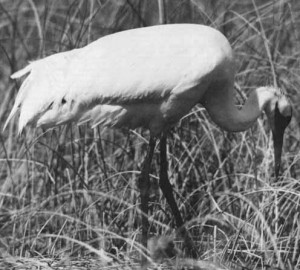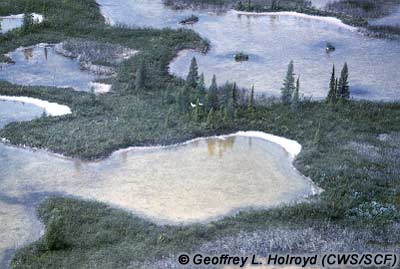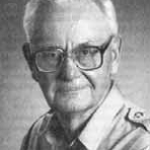****History Briefs compiled by Whooping Crane Conservation Association****
Editor Note: For many years no one knew exactly where whooping cranes nested. Until 1954 whooping crane interests only knew that the birds migrated from “somewhere” in Canada to the Texas Coast. Crane interests had watched as the whooper population declined to 16 individuals in 1941. Pressures were brought on government agencies to protect and manage the birds. It was important to locate the whooper nesting habitats so these essential areas could be protected. In 1954 the whooping crane nesting area was finally located. The story is an interesting part of history. Whooping Crane Conservation Association member Pam Bates researched the literature and came across an article published in “Wild Lands Advocate” that tells the story. This is a follow-up to another article on our web page published on December 23, 2012. Click on the following link for the related story: https://whoopingcrane.com/whooping-cranes-from-despair-to-hope-to-progress/
DISCOVERY OF THE NESTING GROUND OF THE WHOOPING CRANE *
by Dr. W. A. Fuller
I have received a lot of credit for the discovery in 1954 of the only whooping cranes in Canada, but if it hadn’t been for the fire and an observant forester named George Wilson, I might never have gone out to identify the birds. The last nest of a whooping
crane had been seen in about 1926 in Saskatchewan. Members of the U.S. Fish and Wildlife Service (USWS) and others had searched from central Saskatchewan to the delta of the Mackenzie River without success. The USWS was interested because whoopers migrated to Texas.In 1945 I spent the summer working on fish in Lake Athabasca. At the end of the summer I decided that I would never return to the north. However, in 1946 I signed up to spend the summer at Great Slave Lake. The following winter I put together all the data that had been gathered over several years on the “Inconnu” (Stenodus leucichthys) and submitted the result as my masters thesis for the University of Saskatchewan. Convocation took place in early May.

Whooping crane. (From a 1982 Hinterland Who’s Who brochure on the Whooping Crane written by E. Kuyt and published by the Canadian Wildlife Service)
A few days after the ceremony, I turned 23, and on the last day of May I married the young lady who is still my wife. I had previously applied for one of two jobs advertised by the federal government, and I was approved for the one based in Fort Smith, NWT. I found the north gets under your skin, and my wife Marie and I landed in Fort Smith on June 5. My duties centred on mammals in the south half of the Mackenzie District and in Wood Buffalo National Park (WBNP), part of which is in Alberta.In those days, the United States sent a bird guy, Bob Smith, and an assistant down to the Arctic Ocean. They flew out of Fort Smith for two or three days, and I usually took them up on their invitations to go on their sorties. Bob was a great guy, as well as a good pilot and a good bird man. Although waterfowl were the main target, they kept their eyes open for other birds, such as whooping cranes. As late as 1954 they had not made a sure discovery of whoopers, although on an earlier flight with them, one thought he had spotted a crane, but by the time Bob swung the plane around, whatever had been seen had disappeared.
In June 1954, a fire broke out in the northern part of Wood Buffalo Park. On June 30, the fire crew radioed to Fort Smith that one of their pumps was out of order. The forestry guy, George Wilson, went out to the site of the fire in a whirlybird piloted by Don Landells. I was in my office around 4:00 p.m. when a message came in from the plane to the effect that George and Don had seen a few big white birds, which they suspected were whooping cranes. Furthermore, Landells was to make another trip on the same route with a new pump, and if Bill Fuller was at the landing spot at 5:00 p.m he. could go back with Don and the pump.
Bill Fuller was at the landing and ready to go at 5:00 p.m. Don took us back on about the same route he had flown earlier, and we did see some large white birds, which were certainly whoopers. There were young birds as well as adults, so there was reason to believe that the nesting grounds were not too far away. I think we saw about nine birds on that first trip. I sent a telegram to the head office in Ottawa later that evening.
Ottawa’s reply the next morning asked me to keep an eye on the birds whenever there was a chance. I made several trips on an ordinary prop plane. On one such trip I counted thirteen birds, which was just over half of the birds (21, I think) counted in the Texas flock at that time.
The Whooping Crane Society and the USWS were very excited about the discovery, and soon there was talk about a ground survey in 1955. Canadian and American scientists would carry it out. However, the Canadian Wildlife Service (CWS) did not want to commit to that until there was proof of nesting, so I was to take a look next spring as early and as often as possible.
In those days, light aircraft landed on skis in winter and on pontoons in summer. The changeover was made in Edmonton in spring and fall, so it was difficult to find tansportation just when I needed it. While our government plane was in Edmonton, I got a ride with a pilot from Yellowknife on his way to Edmonton.I got another ride in a plane owned by the RCMP in Fort Smith. On that flight I saw what could only be a crane sitting on a nest. So the ground survey was on. Robert P. Allen of the National Audubon Society was to lead it. When Allen arrived in Fort Smith, we made one flight over the area so I could show him the location of the known nests.

The nesting habitat of the Whooping Crane consists of marshes, shallow ponds, small creeks, and patches of wooded terrain and shrubs. Note two whooping cranes in the center of the photograph.
I made other flights, and I think I found a few more nest sites, but when the ground survey came on, I was at a conference in Alaska. The attempted ground survey is a story of its own.In 1956 I moved to Whitehorse in the Yukon, and Ernie Kuyt of the CWS took over work on the cranes. I had flown over the region of the first sightings a number of times. I had noted the tracks in the mud and searched my brains for a mammal that would make such a trail in the soft mud of the lake bottoms. Big birds never crossed my mind until I saw the cranes there in 1955.So who discovered the nesting ground? Wilson and Landells, who saw the big white birds? Me, because I saw young birds as well as mature birds on my sorties in 1955 and was also the first to see a female on a nest in the spring of 1956?It doesn’t really matter. The important point is that an important nesting ground was found. Each year for several more years, Ernie Kuyt found new nests. The total number of cranes in the Texas/WBNP flock has continued to increase in most, if not all, years since 1955.b
* Published in Wild Lands Advocate, The Alberta Wilderness Association, December 2004 • Vol.12, No. 6, pages 16 and 17.


